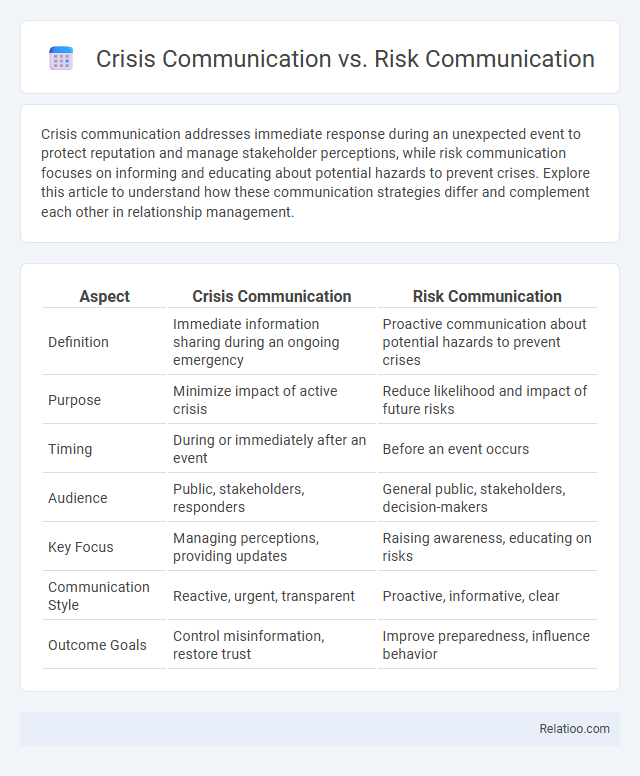Crisis communication addresses immediate response during an unexpected event to protect reputation and manage stakeholder perceptions, while risk communication focuses on informing and educating about potential hazards to prevent crises. Explore this article to understand how these communication strategies differ and complement each other in relationship management.
Table of Comparison
| Aspect | Crisis Communication | Risk Communication |
|---|---|---|
| Definition | Immediate information sharing during an ongoing emergency | Proactive communication about potential hazards to prevent crises |
| Purpose | Minimize impact of active crisis | Reduce likelihood and impact of future risks |
| Timing | During or immediately after an event | Before an event occurs |
| Audience | Public, stakeholders, responders | General public, stakeholders, decision-makers |
| Key Focus | Managing perceptions, providing updates | Raising awareness, educating on risks |
| Communication Style | Reactive, urgent, transparent | Proactive, informative, clear |
| Outcome Goals | Control misinformation, restore trust | Improve preparedness, influence behavior |
Understanding Crisis Communication
Understanding Crisis Communication involves delivering accurate, timely information to stakeholders during unexpected emergencies to minimize confusion and damage. It focuses on maintaining trust and transparency while addressing public concerns and media inquiries. Your ability to effectively communicate can mitigate reputational harm and facilitate a coordinated response across all channels.
Defining Risk Communication
Risk communication involves the exchange of information about potential hazards to help You make informed decisions and reduce uncertainty before a crisis occurs. It focuses on identifying risks, explaining their nature and likelihood, and providing guidance to prevent or mitigate harm. Distinct from crisis communication, which addresses immediate responses during an event, and crisis management, which encompasses overall planning and coordination, risk communication is a proactive, anticipatory process essential for effective emergency preparedness.
Key Differences Between Crisis and Risk Communication
Crisis communication focuses on addressing immediate threats and managing public perception during an ongoing emergency, while risk communication aims to inform and educate stakeholders about potential hazards before they escalate. Crisis communication requires rapid response, clear messaging, and coordination under pressure, contrasting with risk communication's proactive and continuous outreach to build awareness and preparedness. Understanding these differences is essential for effective crisis management, which integrates both communication types to mitigate impacts and support recovery efforts.
Objectives of Crisis Communication
Crisis communication focuses on managing and disseminating timely, accurate information to protect Your organization's reputation and maintain public trust during unexpected events. Its primary objective is to minimize panic, clarify uncertainties, and guide stakeholder responses to ensure safety and stability. Unlike risk communication, which aims to inform about potential hazards before a crisis, and crisis management, which involves overall strategic response coordination, crisis communication specifically targets effective messaging and information flow during the crisis itself.
Goals of Risk Communication
Risk communication aims to provide clear, accurate information to help Your audience understand potential hazards and make informed decisions to minimize harm. It focuses on building trust, promoting awareness, and encouraging proactive behaviors before a crisis occurs. Unlike crisis communication and crisis management, which deal with responding to active emergencies, risk communication prioritizes prevention and preparedness through transparent dialogue.
Timing and Context: Crisis vs. Risk Communication
Crisis communication is deployed immediately during an unfolding event to manage public perception and response when urgency and uncertainty peak, while risk communication is an ongoing process aimed at informing and educating stakeholders about potential hazards before a crisis occurs. Timing is critical; crisis communication addresses the acute phase of an incident, requiring rapid, clear messaging, whereas risk communication functions proactively to build awareness and resilience over the long term. Understanding context distinguishes these approaches: crisis communication responds to actual emergencies, while risk communication focuses on preventing or mitigating future threats through informed decision-making.
Core Strategies for Crisis Communication
Core strategies for crisis communication emphasize timely, transparent, and accurate information dissemination to maintain trust and manage public perception during emergencies. This involves proactive messaging, stakeholder engagement, and coordinated response efforts to address misinformation and evolving situations effectively. Integrating these strategies ensures clear communication channels that support overall crisis management while distinguishing from risk communication, which focuses on prevention and preparedness before a crisis occurs.
Essential Techniques in Risk Communication
Effective risk communication relies on transparent, clear messaging that accurately conveys potential hazards and safety measures to diverse audiences. Techniques such as audience segmentation, use of credible sources, and timely information dissemination help build trust and enable informed decision-making during uncertain situations. Emphasizing empathy and active listening ensures that concerns are addressed and reduces misinformation in crisis contexts.
Common Challenges in Crisis and Risk Communication
Crisis communication and risk communication share common challenges such as managing misinformation, maintaining public trust, and addressing diverse audience perceptions under time pressure. Both require clear, consistent messaging to prevent panic and ensure accurate understanding of risks or crises. Effective crisis management integrates these communication strategies with rapid decision-making and resource coordination to mitigate impact and restore stability.
Best Practices for Integrating Crisis and Risk Communication
Effective integration of crisis communication and risk communication relies on clear, consistent messaging that addresses both immediate threats and long-term hazards. Your organization should develop a unified communication strategy that anticipates potential crises, educates stakeholders about risks, and maintains transparency throughout all stages of an emergency. Leveraging real-time monitoring tools and feedback channels enhances responsiveness and builds trust during critical incidents and risk management efforts.

Infographic: Crisis Communication vs Risk Communication
 relatioo.com
relatioo.com